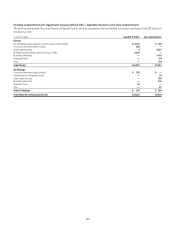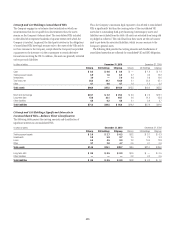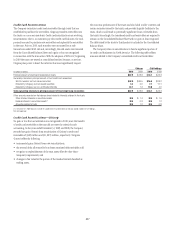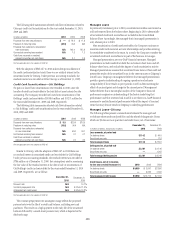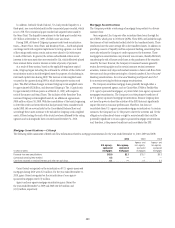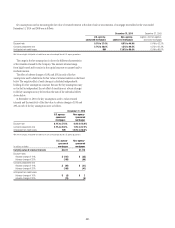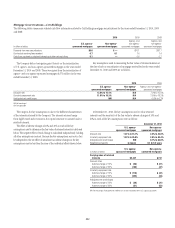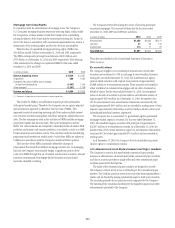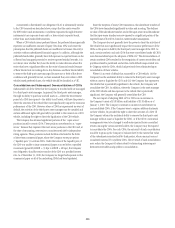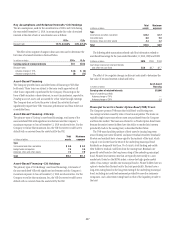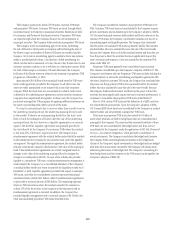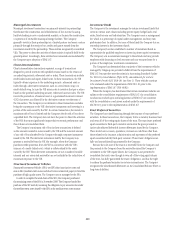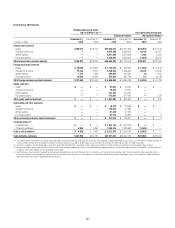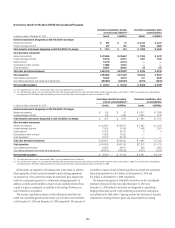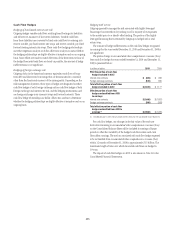Citibank 2010 Annual Report Download - page 247
Download and view the complete annual report
Please find page 247 of the 2010 Citibank annual report below. You can navigate through the pages in the report by either clicking on the pages listed below, or by using the keyword search tool below to find specific information within the annual report.245
The Company administers one conduit that originates loans to third-party
borrowers and those obligations are fully guaranteed primarily by AAA-
rated government agencies that support export and development financing
programs. The economic performance of this government-guaranteed loan
conduit is most significantly impacted by the performance of its underlying
assets. The guarantors must approve each loan held by the entity and the
guarantors have the ability (through establishment of the servicing terms
to direct default mitigation and to purchase defaulted loans) to manage
the conduit’s loans that become delinquent to improve the economic
performance of the conduit. Because the Company does not have the power
to direct the activities of this government-guaranteed loan conduit that most
significantly impact the economic performance of the entity, it was concluded
that the Company should not consolidate the entity. As of December 31, 2010,
this unconsolidated government-guaranteed loan conduit held assets of
approximately $9.6 billion.
Prior to January 1, 2010, the Company was required to analyze the
expected variability of the conduits quantitatively to determine whether the
Company is the primary beneficiary of the conduit. The Company performed
this analysis on a quarterly basis. For conduits where the subordinate
loss notes or third-party guarantees were sufficient to absorb a majority
of the expected loss of the conduit, the Company did not consolidate. In
circumstances where the subordinate loss notes or third-party guarantees
were insufficient to absorb a majority of the expected loss, the Company
consolidated the conduit as its primary beneficiary due to the additional
credit enhancement provided by the Company. In conducting this analysis,
the Company considers three primary sources of variability in the conduit:
credit risk, interest rate risk and fee variability.
Third-Party Commercial Paper Conduits
The Company also provides liquidity facilities to single- and multi-seller
conduits sponsored by third parties. These conduits are independently owned
and managed and invest in a variety of asset classes, depending on the nature
of the conduit. The facilities provided by the Company typically represent a
small portion of the total liquidity facilities obtained by each conduit, and
are collateralized by the assets of each conduit. As of December 31, 2010,
the notional amount of these facilities was approximately $965 million, of
which $415 million was funded under these facilities. The Company is not
the party that has the power to direct the activities of these conduits that
most significantly impact their economic performance and thus does not
consolidate them.
Collateralized Debt and Loan Obligations
A securitized collateralized debt obligation (CDO) is an SPE that purchases
a pool of assets consisting of asset-backed securities and synthetic exposures
through derivatives on asset-backed securities and issues multiple tranches
of equity and notes to investors. A third-party asset manager is typically
retained by the CDO to select the pool of assets and manage those assets over
the term of the CDO. The Company earns fees for warehousing assets prior
to the creation of a CDO, structuring CDOs and placing debt securities with
investors. In addition, the Company has retained interests in many of the
CDOs it has structured and makes a market in those issued notes.
A cash CDO, or arbitrage CDO, is a CDO designed to take advantage of
the difference between the yield on a portfolio of selected assets, typically
residential mortgage-backed securities, and the cost of funding the CDO
through the sale of notes to investors. “Cash flow” CDOs are vehicles in
which the CDO passes on cash flows from a pool of assets, while “market
value” CDOs pay to investors the market value of the pool of assets owned
by the CDO at maturity. Both types of CDOs are typically managed by a
third-party asset manager. In these transactions, all of the equity and notes
issued by the CDO are funded, as the cash is needed to purchase the debt
securities. In a typical cash CDO, a third-party investment manager selects a
portfolio of assets, which the Company funds through a warehouse financing
arrangement prior to the creation of the CDO. The Company then sells the
debt securities to the CDO in exchange for cash raised through the issuance
of notes. The Company’s continuing involvement in cash CDOs is typically
limited to investing in a portion of the notes or loans issued by the CDO and
making a market in those securities, and acting as derivative counterparty for
interest rate or foreign currency swaps used in the structuring of the CDO.
A synthetic CDO is similar to a cash CDO, except that the CDO obtains
exposure to all or a portion of the referenced assets synthetically through
derivative instruments, such as credit default swaps. Because the CDO does
not need to raise cash sufficient to purchase the entire referenced portfolio, a
substantial portion of the senior tranches of risk is typically passed on to CDO
investors in the form of unfunded liabilities or derivative instruments. Thus,
the CDO writes credit protection on select referenced debt securities to the
Company or third parties and the risk is then passed on to the CDO investors
in the form of funded notes or purchased credit protection through derivative
instruments. Any cash raised from investors is invested in a portfolio of
collateral securities or investment contracts. The collateral is then used to
support the obligations of the CDO on the credit default swaps written to
counterparties. The Company’s continuing involvement in synthetic CDOs
generally includes purchasing credit protection through credit default swaps
with the CDO, owning a portion of the capital structure of the CDO in the
form of both unfunded derivative positions (primarily super-senior exposures
discussed below) and funded notes, entering into interest-rate swap and total-
return swap transactions with the CDO, lending to the CDO, and making a
market in those funded notes.


